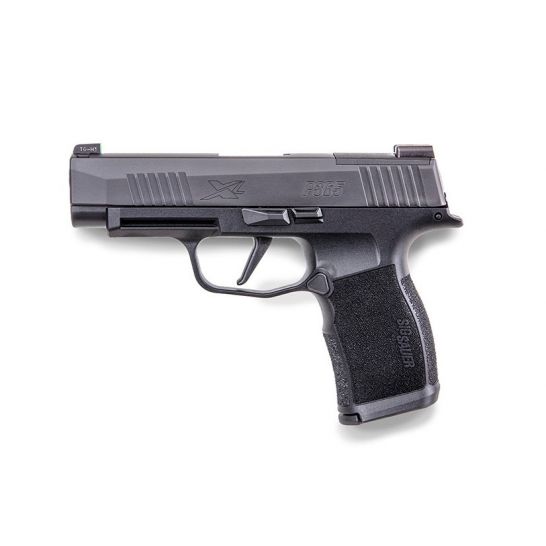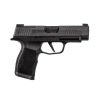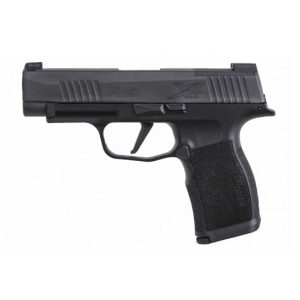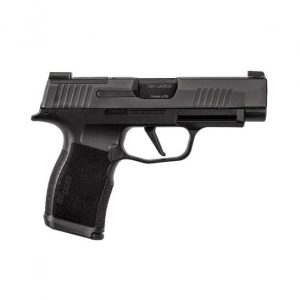Sig Sauer P365 XL 3.7" 9mm Pistol, Black (1 EXTRA MAG FROM SIG SAUER FOR FREE) For Sale
$599.99
The Sig Sauer P365 XL 3.7″ 9mm Pistol, acclaimed for its innovation, quality, and reliability, has received numerous prestigious awards, underscoring its status as a top choice for firearm enthusiasts. Among its accolades, it was named the 2019 Handgun of the Year by the NRA’s Shooting Illustrated Magazine and the 2018 Handgun of the Year by Guns and Ammo Magazine, while also receiving several other industry honors. With a precision-crafted 3.7″ barrel chambered in 9mm, the P365 XL delivers exceptional performance in a compact frame, making it ideal for both personal defense and recreational shooting. For added value, the purchase includes an extra magazine at no additional cost. Trusted by both professionals and enthusiasts, this pistol epitomizes excellence in the firearms industry.
Is the SIG P365 XL a good carry gun?
The SIG P365 XL is generally considered a good carry gun by many firearm enthusiasts and experts. It is praised for its blend of compact size, decent magazine capacity, and shootability. Here are some reasons why it is favored as a carry option:
1. **Size and Capacity**: The P365 XL offers a compact size that is suitable for concealed carry, with a standard magazine capacity of 12+1 rounds, which is quite generous for a gun of its size.
2. **Ergonomics**: It features a comfortable grip and user-friendly controls, making it easier to handle and shoot.
3. **Shootability**: The longer slide and barrel compared to the standard P365 model can enhance accuracy and reduce recoil, providing a better shooting experience.
4. **Optics-Ready**: The P365 XL is optics-ready, allowing users to mount red dot sights without additional modifications.
5. **Quality and Reliability**: The SIG Sauer brand is known for quality and reliability, and the P365 XL upholds this reputation with solid performance.
Overall, the SIG P365 XL is regarded as a versatile and effective choice for concealed carry, combining the benefits of a larger pistol with the convenience of a compact design.
What is the difference between the P365 and the P365 XL?
The primary differences between the SIG Sauer P365 and P365 XL are size, capacity, and features:
1. **Size**: The P365 XL is larger than the P365. The XL model has a longer slide and barrel (3.7 inches compared to the P365’s 3.1-inch barrel), which can improve accuracy and control.
2. **Grip and Frame**: The P365 XL has a longer grip, accommodating a larger magazine and allowing for a full hand grip, which can enhance comfort during shooting.
3. **Magazine Capacity**: While both models use a double-stack magazine, the standard P365 typically comes with a 10-round magazine, whereas the P365 XL comes with a 12-round magazine as standard, thanks to its slightly longer grip.
4. **Sight Radius**: Due to its longer slide, the P365 XL has a longer sight radius, which can help with aiming precision.
5. **Weight**: The P365 XL is slightly heavier due to its larger size and extended components.
6. **Features**: The P365 XL often comes with an optics-ready slide, allowing for the mounting of red dot sights, which is not a standard feature on the basic P365.
Overall, the P365 XL is designed to offer the same concealability as the P365 but with enhancements that may appeal to users looking for improved handling and capacity.
Is the SIG P365 better than Glock?
Determining whether the SIG P365 is better than a Glock depends on personal preferences and specific use cases. Here are some factors to consider:
1. **Size and Concealability**:
– The SIG P365 is known for its compact size and high magazine capacity relative to its size, making it popular for concealed carry.
– Glock offers various models, including compact and subcompact options like the Glock 43 or 26, which are also designed for concealability.
2. **Capacity**:
– The P365 offers a higher capacity in a slim profile with options for 10 to 15-round magazines.
– Some Glock models have comparable capacities, but often in slightly larger frames.
3. **Ergonomics and Comfort**:
– Ergonomics can be subjective; users might find the grip angle and texture of one more comfortable than the other.
4. **Trigger and Performance**:
– Both brands are praised for reliability, but users may prefer the trigger feel and reset of one over the other.
5. **Aftermarket Support and Customization**:
– Glock has extensive aftermarket support, which might be appealing if customization is important to you.
– While the P365 also has aftermarket options, it may not be as extensive as Glock’s.
6. **Price**:
– Prices may vary depending on the specific models and features, with both brands offering options to fit different budgets.
Ultimately, the decision might come down to personal preference, intended use, and how each gun feels in your hand. It’s best to try handling and, if possible, shooting both to see which one better meets your needs.
Does the SIG Sauer P365xl have a safety?
Yes, the SIG Sauer P365XL features an internal safety mechanism but does not have an external manual safety. However, there is a model available that includes a manual thumb safety for those who prefer one.
Why is the P365 so expensive?
The Sig Sauer P365 can be considered expensive due to several factors:
1. **Build Quality and Materials**: Sig Sauer is known for producing high-quality firearms, using robust materials and precise engineering, which can drive up manufacturing costs.
2. **Design and Features**: The P365 offers an innovative design with features like a high-capacity magazine relative to its size, a compact frame, night sights, and a comfortable grip, which can add to its value and price.
3. **Brand Reputation**: Sig Sauer is a well-respected brand in the firearms industry, and its products often come at a premium due to the brand’s reputation for reliability and performance.
4. **Research and Development**: The costs associated with designing and developing new technologies or features in firearms can also contribute to a higher price point.
5. **Market Demand**: High demand for reliable, compact, and concealable firearms for personal defense can also impact pricing, especially if supply is limited.
6. **Regulatory and Testing Expenses**: Compliance with safety standards and regulatory requirements, along with rigorous testing processes, can increase the overhead costs for manufacturing firearms.
These factors collectively contribute to the higher price tag of the Sig Sauer P365.
Which Sig Sauer P365 is best for concealed carry?
The best Sig Sauer P365 model for concealed carry can vary based on personal preference, desired features, and intended use. However, the original Sig Sauer P365 is highly regarded for its compact size, 10+1 capacity, and overall reliability, making it an excellent choice for concealed carry. For those preferring a slightly larger grip for better handling, the P365 XL is an option, offering a longer barrel and slide, along with a 12+1 capacity. For additional customization, the P365 SAS features flush sights for snag-free drawing. Ultimately, the best model depends on your specific needs and comfort with the firearm.
How much should I pay for a P365?
The cost of a SIG Sauer P365 can vary based on several factors such as location, retailer, demand, and any additional features or accessories included. As of my last update, the price for a new P365 model typically ranges from $499 to $599 USD. However, prices can fluctuate, so it’s a good idea to check with local gun shops or online retailers for the most current pricing. Additionally, consider any taxes, transfer fees, or background check fees that might apply in your area.
What does XL mean on P365?
XL on the P365 refers to the Sig Sauer P365 XL, which is a variant of the P365 pistol. The “XL” signifies that this model has a longer slide and barrel, as well as an extended grip, compared to the standard P365. This design is intended to provide improved accuracy and increased capacity, making it suitable for both concealed carry and everyday shooting.
What is the competitor of the SIG P365 XL?
The competitor of the SIG P365 XL is often considered to be the Springfield Hellcat. Other notable competitors include the Glock 43X and the Smith & Wesson M&P Shield Plus. These firearms are all popular choices in the concealed carry market, offering similar features and calibers.
What pistol do FBI agents carry?
FBI agents typically carry the Glock 19M or the Glock 17M as their standard-issue service pistols.
What are the cons of the Sig P365?
The Sig P365 is a popular concealed carry handgun, but it does have some cons that potential buyers might consider:
1. **Capacity vs. Size**: While the P365 is praised for its high capacity in a small frame, some users feel that managing recoil can be more challenging due to its compact size.
2. **Trigger Feel**: Some shooters find the trigger pull to be heavier or less smooth compared to other pistols in the same category.
3. **Grip Comfort**: The small grip, while beneficial for concealability, might be uncomfortable for those with larger hands, affecting overall control and accuracy.
4. **Sight Options**: Although the P365 generally comes with decent sights, sight options and visibility might not meet everyone’s preferences without additional modifications.
5. **Price**: It can be on the pricier side compared to other similar firearms, which might be a deterrent for budget-conscious buyers.
6. **Slide and Control Manipulation**: The smaller size could make operating the slide, safety, and other controls more difficult for individuals with larger hands or less hand strength.
7. **Availability of Accessories**: Due to its size, finding aftermarket accessories and holsters that fit perfectly can sometimes be challenging, though this is improving over time.
8. **Initial Model Concerns**: Early models experienced reliability issues such as primer drag and firing in unexpected conditions, though these have largely been addressed in later versions.
Every firearm has its trade-offs, and potential buyers should consider these factors based on their personal needs and preferences.
Is the Sig safer than the Glock?
The safety of a firearm, such as Sig Sauer versus Glock, depends on several factors including the design features of each model, user handling, training, and specific context of use.
Sig Sauer and Glock both produce firearms with excellent reputations for reliability and safety, but they employ different mechanisms and designs. For instance:
1. **Trigger Mechanism**: Glocks typically have a “Safe Action” system, which includes a trigger safety, firing pin safety, and drop safety that works without a manual safety lever. Sig Sauer pistols often have a decocker, and some models feature a manual safety lever.
2. **Training and Handling**: Safety also greatly relies on the user’s training and discipline in firearm handling more than the specific safety features of the pistol.
3. **Use Case**: Different models may be more suited to specific use cases (e.g., law enforcement, concealed carry), which can affect perceptions of safety.
It is crucial to compare specific models rather than brands overall. Comprehensive safety involves proper handling, maintenance, and adherence to firearm safety rules. Ultimately, neither is inherently “safer,” and personal preference, training, and intended use are significant factors in determining which is appropriate for an individual.
What are the cons of the SIG P365?
The SIG P365, while popular and generally well-regarded, does have some cons that potential buyers might consider:
1. **Size for Larger Hands**: Some users with larger hands may find the grip a bit small or uncomfortable over extended periods of use.
2. **Recoil**: Due to its small size and lightweight frame, it can have significant recoil, which might be challenging for some shooters to manage effectively.
3. **Magazine Capacity**: While higher than many other pistols of its size, some users might find the 10-round magazine capacity (standard version) limiting compared to larger handguns.
4. **Sight Issues**: Some users have reported issues with the factory sights, such as misalignment or needing adjustment.
5. **Trigger**: The trigger pull can be heavier than expected for some users, requiring more force which might affect accuracy and shooting comfort.
6. **Price**: The SIG P365 typically comes at a higher price point compared to some competitors, which might be a con for budget-conscious buyers.
It’s important to note that individual experiences can vary, and what might be a con for one person could be a non-issue for another.
Is p365XL single or double stack?
The SIG Sauer P365XL is considered a micro-compact, double-stack pistol. Despite its compact size, it features a double-stack magazine, allowing for a higher ammunition capacity compared to traditional single-stack firearms.
Is the SIG P365 XL Plus P rated?
Yes, the SIG P365 XL is rated for +P ammunition. However, it’s important to use +P ammunition sparingly as regular use can increase wear and tear on the firearm. Always refer to the manufacturer’s guidelines and ensure safe handling practices.
| Model | P365 XL |
|---|---|
| Overall Length | 6.6" |
| Frame Material | Steel |
| Grips | Polymer |
| Sights | X-Ray 3 Day/Night Sights |
| Trigger | Flat w/ 90 degree Break |
Be the first to review “Sig Sauer P365 XL 3.7" 9mm Pistol, Black (1 EXTRA MAG FROM SIG SAUER FOR FREE)” Cancel reply
Related products
Sig Sauer P365 XL
Sig Sauer P365 XL
Sig Sauer P365 XL X Series 9mm Pistol, Stainless – 365XL-9-BXR3-MS-10




Reviews
There are no reviews yet.